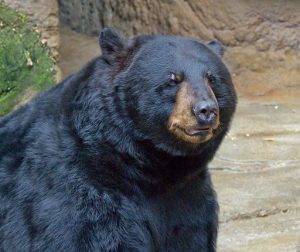Ordinary Bears
American Black Bear
Black bear are cute

Sub-species of the American Black Bear
There are numerous sub-species of the American black bear.
| Sub-species name | Common name | Distribution | Description |
|---|---|---|---|
| Ursus americanus americanus | Eastern black bear | Eastern Montana to the Atlantic coast, from Alaska south and east through Canada to Maine and south to Texas. Thought to be increasing in some regions. | Common to Eastern Canada and U.S. wherever suitable habitat is found. A large-bodied subspecies, almost all specimens have black fur. May very rarely sport a white blaze on chest. |
| Ursus americanus californiensis | California black bear | Mountain ranges of southern California, north through the Central Valley to southern Oregon | Able to live in varied climates: found in temperate rainforest in the north and in the south. Small numbers may feature a cinnamon brown fur. |
| Ursus americanus carlottae | Haida Gwaii black bear, Queen Charlotte black bear | Haida Gwaii/Queen Charlotte Islands and Alaska | Generally larger than its mainland counterparts with a huge skull and molars, and is found only as a black color phase |
Description of the American Black Bear
Build
The skulls of are broad, with narrow muzzles and large jaw hinges. Females tend to have more slender and pointed faces than males. Their claws are typically black or grayish brown. The ears are small and rounded, and are set well back on the head. Black bears are highly dexterous, being capable of opening screw-top jars and manipulating door latches. They also have great physical strength.
If you would like to see how a baby black bear behaves, you can watch this video:
Pelage
The fur is soft, with dense underfur and long, coarse, thick guard hairs. Despite their name, black bears show a great deal of color variation. Individual coat colors can range from white, blond, cinnamon, or light brown to dark chocolate brown or to jet black, with many intermediate variations existing. Bluish tinged black bears occur along a portion of coastal Alaska and British Columbia. White to cream colored black bears occur in coastal islands and the adjacent mainland of south-western British Columbia.

Favourite Foods

Black bears are omnivorous animals, but mostly eat vegetation and fruits. Despite their tough appearance and long teeth and claws, 85% of a black bear's diet comes from plants. They also like to eat honey and can rip open a whole tree to get into a beehive. Black bears' thick coats protect them from stinging bees, meaning they can eat the honeycombs as fast or as slowly as they like. At night, black bears in the Pacific Northwest fish for salmon in rivers. A few enterprising bears also venture into human-populated areas to steal from trashcans or campsites. In the fall, when they are preparing for hibernation, black bears eat lots of bugs like ants and bees for their protein. Black bears also sometimes catch baby deer, cows and moose, but they are more likely to try to steal carcasses from more active predators like wolves, coyotes and cougars. The extra proteins help them gain fat for their long, annual hibernation.
Diet of the American Black Bear - How Does it Compare?
How does the diet of the black bear differ from that of the Grizzly Bear?
- How does it differ in volume?
- How does it differ in variety
How to Avoid Being Eaten by a Black Bear
Hungry, solo male bears are bad news (bears). There are a few safety tips to keep in mind to avoid being eaten:
- Travel in groups of 3 (or more)
- Recognize signs that bears may be in the area
- Put food and garbage away
- Have bear spray on hand (yes, it's a thing)
- Don't be aggressive or hostile towards bears if you see them
Source: How to Avoid Being Eaten by a Black Bear
https://www.youtube.com/watch?v=fsg5vjwchLs'
Indigenous Names
ᒋᔐᔮᒄ - Cree-English dictionary
Bear - ᒋᔐᔮᒄ
Polar Bear - ᐋᐸᔅᒄ
- The American black bear ([pb_glossary id="967"]Ursus americanus[/pb_glossary]) is a medium-sized bear native to North America. It is the continent's smallest and most widely distributed bear species. Black bears are omnivores with their diets varying greatly depending on season and location. They typically live in largely forested areas, but do leave forests in search of food. The American black bear is the world's most common bear species.[footnote]Enter your footnote content here. ↵
Shaped by a Mediterranean climate (mild, wet winters and hot dry summers) and wildfire, featuring summer-drought-tolerant plants with hard sclerophyllous evergreen leaves, as contrasted with the associated soft-leaved, drought-deciduous, scrub community of coastal sage scrub, found below the chaparral biome. (Wikipedia)
they are cute but they can eat you

